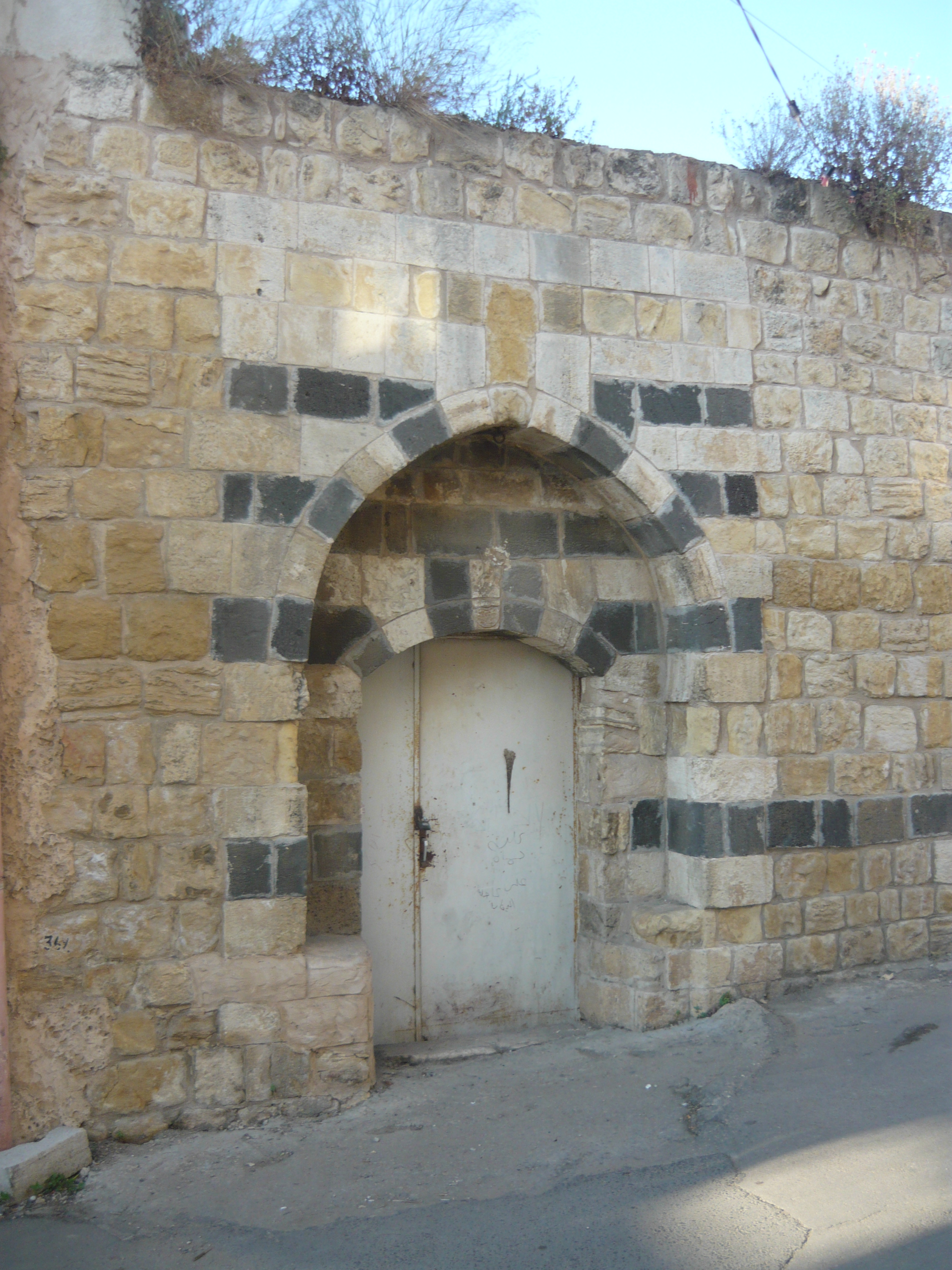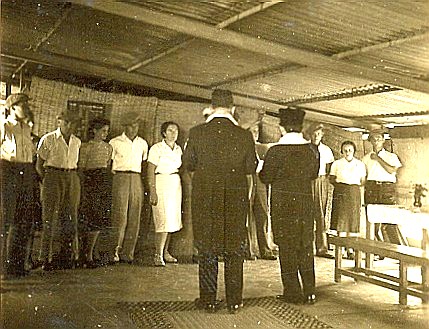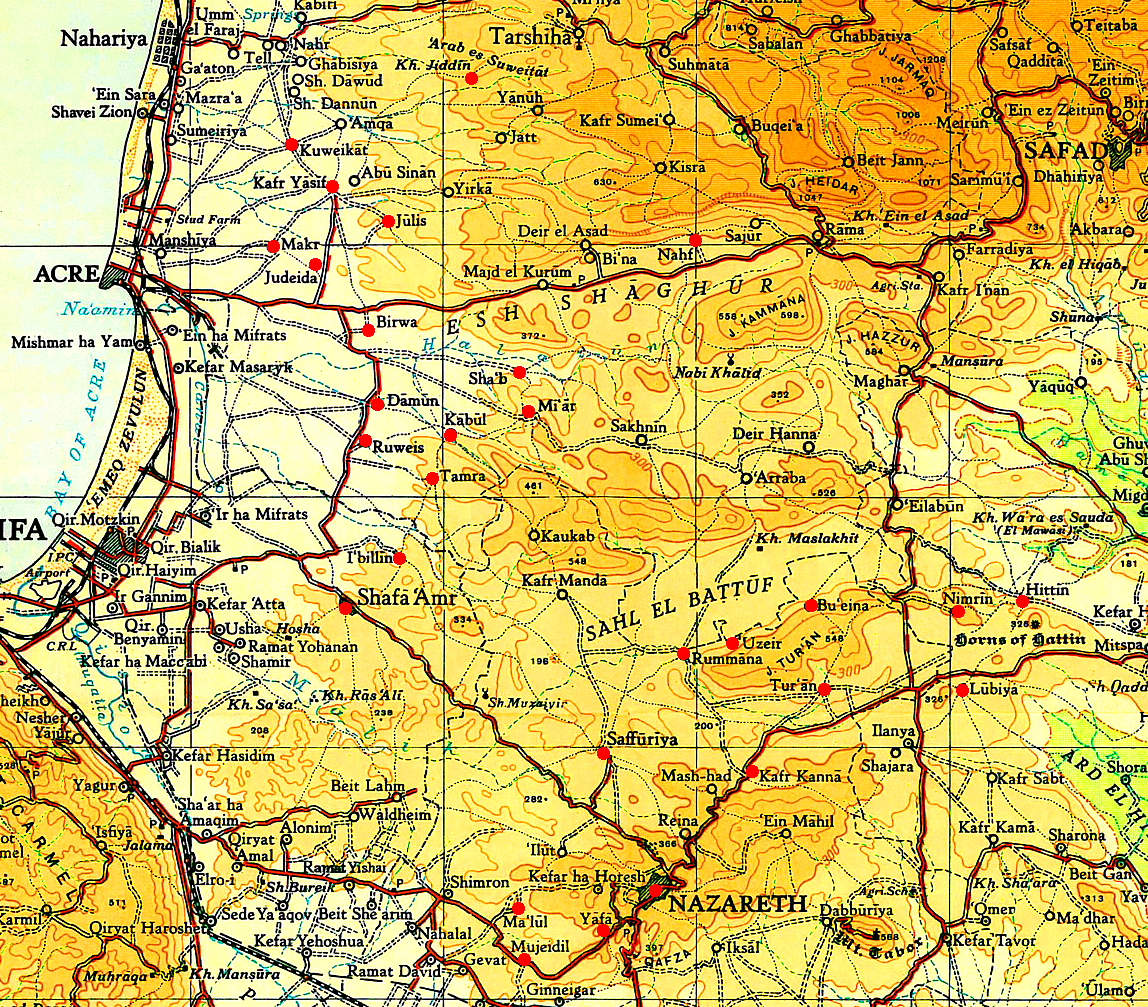|
Jiddin
Khirbat Jiddin ( ar, خربة جدين, list=ruins of Jiddin), known in the Kingdom of Jerusalem as Judin, was an Ottoman fortress in the western Upper Galilee, originally built by the Teutonic Order after 1220 as a crusader castle, 16 km northeast of the city of Acre, which at the time was the capital of the Kingdom of Jerusalem. The castle was destroyed by the Mamluk sultan Baibars sometime between 1268-1271 and lay in ruins until being rebuilt and expanded by the Arab ruler Zahir al-Umar as ''Qal'at Jiddin'' ( ar, قلعة جدين, lit=castle of Jiddin) in the 1760s, only to be destroyed again around 1775 by Jazzar Pasha.Pringle et al., 1994. The ruined fortress, known as Khirbat Jiddin, was later inhabited by the al-Suwaytat Bedouin tribe. According to a 1945 census, there were 1500 Muslims living in the area. Khirbat Jiddin land totaled 7,587 dunums, of which however all but 34 were officially listed as non-cultivable; 4,238 were owned by Arabs and 3,349 dunums owne ... [...More Info...] [...Related Items...] OR: [Wikipedia] [Google] [Baidu] |
Yehiam
Yehi'am ( he, יְחִיעָם) is a kibbutz in northern Israel. Located at the western Upper Galilee, eight miles east of the coastal town of Nahariya and 14 miles south-east of the border with Lebanon it falls under the jurisdiction of Mateh Asher Regional Council. In it had a population of . It is located around 365 meters above sea level Yehiam is situated next to the ruins of the Ottoman-era castle of Jiddin, built on top of the 13th-century Crusader castle of Judin. History Yehiam was founded by a group of the socialist Zionist Hashomer Hatzair youth movement—Holocaust survivors from Hungary and members from Yishuv—who named themselves Kibbutz HaSela (lit. ''The Rock''), whereas "kibbutz" is still understood here as a wandering "collective", not as a settlement. For a while the HaSela collective lived in tents in the area of Kiryat Haim, looking for an appropriate place to settle. Eventually, on 26 November 1946, Kibbutz Yehiam was established at the site of the me ... [...More Info...] [...Related Items...] OR: [Wikipedia] [Google] [Baidu] |
Zahir Al-Umar
Zahir al-Umar al-Zaydani, alternatively spelled Daher al-Omar or Dahir al-Umar ( ar, ظاهر العمر الزيداني, translit=Ẓāhir al-ʿUmar az-Zaydānī, 1689/90 – 21 or 22 August 1775) was the autonomous Arab ruler of northern Palestine in the mid-18th century, while the region was part of the Ottoman Empire. For much of his reign, starting in the 1730s, his domain mainly consisted of the Galilee, with successive headquarters in Tiberias, Deir Hanna and finally Acre, in 1750. He fortified Acre, and the city became the center of the cotton trade between Palestine and Europe. In the mid-1760s, he reestablished the port town of Haifa nearby. Zahir withstood sieges and assaults by the Ottoman governors of Damascus, who attempted to limit or eliminate his influence. He was often supported in these confrontations by the Shia Muslim clans of Jabal Amil. In 1771, in alliance with Ali Bey al-Kabir of the Egypt Eyalet and with backing from Russia, Zahir captured Sidon, whi ... [...More Info...] [...Related Items...] OR: [Wikipedia] [Google] [Baidu] |
Yehi'am Fortress National Park
Yehi'am Fortress National Park is an Israeli national park in the western Upper Galilee on the grounds of Kibbutz Yehi'am, whose main attraction are the ruins of a hilltop castle. History The structure is based on the Crusader-time Iudyn Castle built by the Teutonic Order after 1220, destroyed by the Mamluk sultan Baibars sometime between 1268 and 1271, rebuilt and expanded by Zahir al-Umar as Qal'at Jiddin (Jiddin Castle) in the 1760s and destroyed again by Ahmed Jezzar Pasha around 1775. The ruined fortress, known as Khirbat Jiddin (lit. "ruins of Jiddin"), was later inhabited by Bedouin tribes. The establishment of a kibbutz in 1946 is described on the Kibbutz Yehi'am page. The buildings include a watch tower with a lookout platform, mosque, and large vaulted hall. The 1948 trenches laid around the castle can also be visited. Archaeological finds in the park but outside the castle precinct include the remains of a Roman fort, a Byzantine monastery, burial caves, ston ... [...More Info...] [...Related Items...] OR: [Wikipedia] [Google] [Baidu] |
Ga'aton
Ga'aton ( he, גַּעְתּוֹן) is a kibbutz in northern Israel. Located in the western Galilee, it falls under the jurisdiction of Mateh Asher Regional Council. In it had a population of . Etymology The name Ga'aton is taken from the Ga'aton River that passes nearby and flows through Nahariya into the Mediterranean Sea. Ga'aton, in the past transliterated as Gaathon, is also the name of a biblical town in the allotment of Asher, located at one of the ancient tells (mounds) near the kibbutz. The tell known as Horbat Ga'aton ("ruins of Ga'aton"; from Arabic Khirbat Ja'tun) northwest of the kibbutz and near the Ga'aton River is one candidate, and there are other tells in the vicinity with remains from the time of the Hebrew Bible. Most English translations of the Hebrew Bible offer the name ''Gaash'' (); in the Latin of the Vulgate it is ''Gaas''. History Ceramic remains found in Ga'aton were dated to the Byzantine era, 5th to 7th century CE. In the Crusader period, Ga'at ... [...More Info...] [...Related Items...] OR: [Wikipedia] [Google] [Baidu] |
Acre Subdistrict, Mandatory Palestine
The Acre Subdistrict ( ar, قضاء عكا Qadaa Akka, he, נפת עכו Nefat Akko) was one of the subdistricts of Mandatory Palestine. It was located in modern-day northern Israel, having nearly the same territory as the modern-day Acre County. The city of Acre was the district's capital. The subdistrict was transformed into Northern District's Acre Subdistrict. Borders * Safad Subdistrict (East) * Tiberias Subdistrict (East) * Nazareth Subdistrict (South) * Haifa Subdistrict (South West) * Lebanon (North) History of attachment to a district The layout of the districts of Mandatory Palestine changed several times: * 1922 Northern District * 1937 Galilee District * 1939 Galilee and Acre District * 1940 Galilee District * 1948 dissolution The territory is now covered by the Northern District of Israel. Depopulated towns and villages (current localities in parentheses) * Amqa ( Amka) * Arab al-Samniyya ( Ya'ara) * al-Bassa ( Betzet, Rosh HaNikra, Shlomi, Tzah ... [...More Info...] [...Related Items...] OR: [Wikipedia] [Google] [Baidu] |
Operation Dekel
Operation Dekel ( he, מבצע דקל , Mivtza Dekel, Operation Palm Tree), was the largest offensive by Israeli forces in the north of Palestine after the first truce of the 1948 Arab-Israeli War. It was carried out by the 7th Armoured Brigade led by Canadian volunteer Ben Dunkelman (called Benjamin Ben-David in Israel), a battalion from the Carmeli Brigade, and some elements from the Golani Brigade between 8–18 July. Its objective was to capture Nazareth and the Lower Galilee. On 15 July Israeli aircraft bombed Saffuriya village and caused panic among the population; many of the villagers fled northwards toward Lebanon, others found shelter in Nazareth, leaving about 100 elderly people behind. On the evening of 16 July, Nazareth surrendered to the Israelis after a light fight which left one Israeli dead and one wounded. The Arab Liberation Army forces in the village under the command of Fawzi al-Qawuqji retreated to the mountains in the north. In sharp contrast to the s ... [...More Info...] [...Related Items...] OR: [Wikipedia] [Google] [Baidu] |
Teutonic Order
The Order of Brothers of the German House of Saint Mary in Jerusalem, commonly known as the Teutonic Order, is a Catholic religious institution founded as a military society in Acre, Kingdom of Jerusalem. It was formed to aid Christians on their pilgrimages to the Holy Land and to establish hospitals. Its members have commonly been known as the Teutonic Knights, having a small voluntary and mercenary military membership, serving as a crusading military order for the protection of Christians in the Holy Land and the Baltics during the Middle Ages. Purely religious since 1810, the Teutonic Order still confers limited honorary knighthoods. The Bailiwick of Utrecht of the Teutonic Order, a Protestant chivalric order, is descended from the same medieval military order and also continues to award knighthoods and perform charitable work. Name The name of the Order of Brothers of the German House of Saint Mary in Jerusalem is in german: Orden der Brüder vom Deutschen Haus der ... [...More Info...] [...Related Items...] OR: [Wikipedia] [Google] [Baidu] |
Muslim
Muslims ( ar, المسلمون, , ) are people who adhere to Islam, a Monotheism, monotheistic religion belonging to the Abrahamic religions, Abrahamic tradition. They consider the Quran, the foundational religious text of Islam, to be the verbatim word of the God in Abrahamic religions, God of Abraham (or ''Allah'') as it was revealed to Muhammad, the Muhammad in Islam, main Islamic prophet. The majority of Muslims also follow the teachings and practices of Muhammad (''sunnah'') as recorded in traditional accounts (''hadith''). With an estimated population of almost 1.9 billion followers as of 2020 year estimation, Muslims comprise more than 24.9% of the world's total population. In descending order, the percentage of people who identify as Muslims on each continental landmass stands at: 45% of Islam in Africa, Africa, 25% of Islam in Asia, Asia and Islam in Oceania, Oceania (collectively), 6% of Islam in Europe, Europe, and 1% of the Islam in the Americas, Americas. Addition ... [...More Info...] [...Related Items...] OR: [Wikipedia] [Google] [Baidu] |
Jews
Jews ( he, יְהוּדִים, , ) or Jewish people are an ethnoreligious group and nation originating from the Israelites Israelite origins and kingdom: "The first act in the long drama of Jewish history is the age of the Israelites""The people of the Kingdom of Israel and the ethnic and religious group known as the Jewish people that descended from them have been subjected to a number of forced migrations in their history" and Hebrews of historical Israel and Judah. Jewish ethnicity, nationhood, and religion are strongly interrelated, "Historically, the religious and ethnic dimensions of Jewish identity have been closely interwoven. In fact, so closely bound are they, that the traditional Jewish lexicon hardly distinguishes between the two concepts. Jewish religious practice, by definition, was observed exclusively by the Jewish people, and notions of Jewish peoplehood, nation, and community were suffused with faith in the Jewish God, the practice of Jewish (religious) la ... [...More Info...] [...Related Items...] OR: [Wikipedia] [Google] [Baidu] |
Kibbutz
A kibbutz ( he, קִבּוּץ / , lit. "gathering, clustering"; plural: kibbutzim / ) is an intentional community in Israel that was traditionally based on agriculture. The first kibbutz, established in 1909, was Degania. Today, farming has been partly supplanted by other economic branches, including industrial plants and high-tech enterprises. Kibbutzim began as utopian communities, a combination of socialism and Zionism. In recent decades, some kibbutzim have been privatized and changes have been made in the communal lifestyle. A member of a kibbutz is called a ''kibbutznik'' ( he, קִבּוּצְנִיק / ; plural ''kibbutznikim'' or ''kibbutzniks''). In 2010, there were 270 kibbutzim in Israel with population of 126,000. Their factories and farms account for 9% of Israel's industrial output, worth US$8 billion, and 40% of its agricultural output, worth over US$1.7 billion. Some kibbutzim had also developed substantial high-tech and military industries. For exampl ... [...More Info...] [...Related Items...] OR: [Wikipedia] [Google] [Baidu] |
Mandatory Palestine
Mandatory Palestine ( ar, فلسطين الانتدابية '; he, פָּלֶשְׂתִּינָה (א״י) ', where "E.Y." indicates ''’Eretz Yiśrā’ēl'', the Land of Israel) was a geopolitical entity established between 1920 and 1948 in the region of Palestine under the terms of the League of Nations Mandate for Palestine. During the First World War (1914–1918), an Arab uprising against Ottoman rule and the British Empire's Egyptian Expeditionary Force under General Edmund Allenby drove the Ottoman Turks out of the Levant during the Sinai and Palestine Campaign. The United Kingdom had agreed in the McMahon–Hussein Correspondence that it would honour Arab independence if the Arabs revolted against the Ottoman Turks, but the two sides had different interpretations of this agreement, and in the end, the United Kingdom and France divided the area under the Sykes–Picot Agreementan act of betrayal in the eyes of the Arabs. Further complicating the issue was t ... [...More Info...] [...Related Items...] OR: [Wikipedia] [Google] [Baidu] |
Byzantine Empire
The Byzantine Empire, also referred to as the Eastern Roman Empire or Byzantium, was the continuation of the Roman Empire primarily in its eastern provinces during Late Antiquity and the Middle Ages, when its capital city was Constantinople. It survived the fragmentation and fall of the Western Roman Empire in the 5th century AD and continued to exist for an additional thousand years until the fall of Constantinople to the Ottoman Empire in 1453. During most of its existence, the empire remained the most powerful economic, cultural, and military force in Europe. The terms "Byzantine Empire" and "Eastern Roman Empire" were coined after the end of the realm; its citizens continued to refer to their empire as the Roman Empire, and to themselves as Romans—a term which Greeks continued to use for themselves into Ottoman times. Although the Roman state continued and its traditions were maintained, modern historians prefer to differentiate the Byzantine Empire from Ancient Rome a ... [...More Info...] [...Related Items...] OR: [Wikipedia] [Google] [Baidu] |





